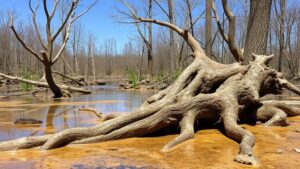Amber Forest Floors: Exploring Prehistoric Habitats Preserved in Golden Resin
Amber Forest Floors: Exploring Prehistoric Habitats Preserved in Golden Resin
Amber, often prized for its beauty and unique inclusions, is not just a gem; it holds the history of ancient ecosystems within its golden depths. For rockhounds and mineral collectors, understanding amber and its prehistoric origins provides invaluable insight into both its formation and the life it once preserved. In this article, we will delve into the fascinating world of amber forests and explore what makes this geological wonder a coveted find.
The Formation of Amber
Amber is the fossilized resin of ancient trees, predominantly from species in the Pinaceae (pine) family. This organic compound began its transformation more than 300 million years ago, during the late Carboniferous period, with continued activity well into the Cretaceous period.
During its formation, tree resin seeped into the environment, trapping various organisms such as insects, spiders, and plants. Over millennia, geological processes — including heat and pressure — converted this resin into the solid, durable substance known as amber.
Amber Forests: A Snapshot in Time
The discovery of amber deposits often includes hints of the ancient habitats in which they were formed. These amber forests served as rich environments where countless species thrived. Each piece of amber, therefore, is akin to a time capsule, preserving a unique snapshot of the Earth’s biodiversity. One of the most significant sources of amber is the Baltic region, particularly Latvia, Lithuania, and Poland, where evidence suggests these forests once flourished around 40-60 million years ago.
- Layered formations indicate tree species and types of vegetation that once dominated these areas.
- Fossils embedded in amber include over 1,000 species of insects, providing insight into biodiversity during the Cenozoic era.
Unique Inclusions: What Amber Can Tell Us
The real allure of amber lies in its inclusions. From ancient insects to plant material, these elements tell a story about the environment at the time of the ambers creation. For example, researchers discovered a piece of amber containing a remarkably well-preserved feather, believed to belong to a Cretaceous-era bird. This find not only confirmed the existence of avian species during this period but also provided clues about their evolution.
According to a study published in Nature Communications, molecular evidence from amber inclusions helps scientists identify prehistoric ecosystems with an estimated accuracy of over 85%.
Collecting Amber: Tips for Rockhounds
For collectors interested in amber, there are several key considerations when searching for and selecting pieces. Here are practical tips to enhance your collecting experience:
- Know Your Sources: Baltic amber is highly sought after, but other locations like the Dominican Republic and Myanmar also yield fascinating specimens. Research the geology of each area to understand what types of inclusions you may find.
- Examine the Clarity: Clear amber with visible inclusions typically commands higher prices. When purchasing, observe the piece against strong light to evaluate its color and clarity.
- Consider Size and Shape: Larger pieces tend to be rarer, but unique shapes with interesting inclusions can also hold significant value.
- Beware of Fakes: Many synthetic ambers exist, particularly on online marketplaces. Familiarize yourself with how to distinguish genuine amber from imitations, such as through scent tests (real amber has a distinct smell when heated).
Real-World Applications of Amber
Beyond aesthetics and collection, amber has historical and scientific applications. Archaeologists have used amber to piece together ancient trade routes; for example, the Amber Road was a network of trade that spanned from the Baltic Sea to the Mediterranean. Also, amber has been used in traditional medicine for its believed healing properties, and modern scientists study its chemical components for potential pharmaceutical applications.
Conclusion: The Golden History in Your Hands
Amber serves as a tangible connection to prehistoric life, encapsulating moments of the Earths history in a form that can be held and appreciated. For collectors, each piece of amber presents the thrill of discovery, enriched by the stories of creatures and ecosystems long gone. As you navigate the world of amber, consider not just the beauty of what you hold, but the intricate history and science that it represents. Whether you are an experienced mineral collector or just beginning your journey, amber is truly a golden treasure waiting to be unearthed.
Remember, no matter where your passion for collecting leads you, the lessons contained within each fragment of amber can deepen your appreciation for the vibrant history of our planet.



